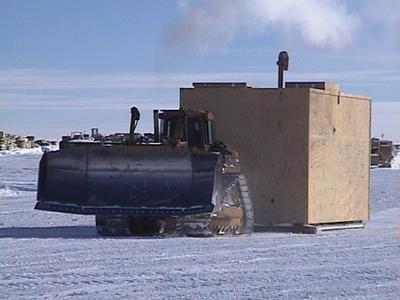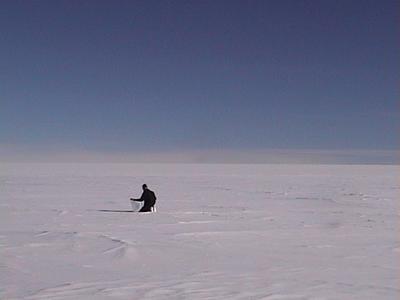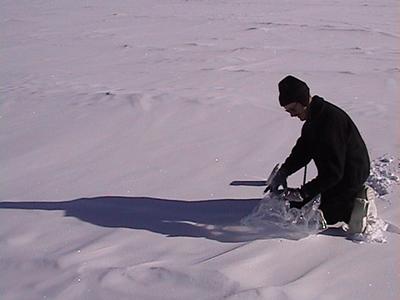15 December, 2002
15 December, 2002
About the ice expedition yesterday : we drove 20 km out from the
station in a German ski resort specialty vehicle called a
PistenBully. It's a little bug, with 2 seats in front, a square cabin
in back, and caterpillar tracks, and it's just the thing for a bumpy
ride across the trackless deserts of the Antarctic plateau.
Sitting in the back was almost identical to one of those really bad
Disneyland rides where they pack you into some kind of a box with
seats, show you some silly rescue mission movie about being shrunk to
the size of blood cells, then you get injected into the aorta of some
actor who¸s supposed to important, like the King of Slobovia. Then
they fire up the microchip-controlled hydraulics under the box, and
it¸s sort of timed to the movie, so when you make a wrong turn and go
through the heart, the hydraulics really shake the box around, and
you feel really sickened by the ride, how long you waited in line for
this, and how much money you forked over to the Disney empire for
this.
It was like that, except we were really on a mission, and didn't pay
for admission, and didn't eat bad, overpriced food, and didn't wait
in line, and Antarctica was right outside the window.
20 km out, on radial F from the pole. There was already a track from
last week, when a similar mission came out to measure the snow level
on a regularly-spaced series of stakes. It's not clear how much snow
levels change, year to year, decade to decade, or even longer
intervals. This is an important question for all kinds of reasons. Is
the accumulation of snow around the pole station an anomaly, or
caused by the buildings of the station, or a sort of moving ripple,
like a big sand dune ? Or it might be due to bedrock features 2 miles
below, which cause surface bumps and ripples as the ice passes slowly
over on its 10 meter per year to the sea.
From a topographic map that Joe McConnell had, it was clear that this
area isn't exactly flat. In fact, there¸s changes in elevation on the
order of several meters over our 20 km trip. At one point, fairly
close to the station, we went into a slow dip, where the entire
station dropped out of site.
Pretty remote. Andy, our driver, NOAA Clean Air Lab manager (and
later that evening, guitarist) left the engine running. It's a long
walk back to the stations.
I was struck by how much like a desert this was. 4 wheel-drive road
wiggling off over the horizon, drifting dust (ice), little dunes
(sastrugi), too dry for life to get much of a hold. It reminded of
some places in Baja California or the high desert in Nevada.
Ice scientist Joe McConnell's mission was fairly simple : stop every
2 kilometers and collect samples of the surface ice. The hard part
comes back in the lab. Joe planned to analyze each sample for
synthetic chemicals (hydrocarbons), and establish a sort of pollution
gradient stretching out from the Pole Station. This radial put us
upwind of the station, and Joe planned a similar mission the next day
downwind of the station.
I've done some of this work, and it's very demanding in the lab.
You¸re looking for trace amounts of these chemicals, so all of the
work has to be very very clean.
Joe does other similar kinds of ice work here at the Pole and in
Greenland. Here, he's been digging a pit, and looking at how certain
types of synthetic refrigerants may have penetrated into the surface
layers of the ice. There's some evidence that the top 10 meters or so
of ice acts as a sort of sponge, and there's quite a bit of air (and
pollutant) movement through this entire layer.
Joe's pit is out in the Clean Air Sector, a wedge extending upwind
from the station, anchored at the tip of wedge by the Clean Air Lab.
No machines and hardly any activity of any kind is permitted in Clean
Air. I even heard that a Norwegian expedition planning on recovering
Amundsen's tent (he was first to the pole in 1911) was denied
permission, because they were going to dig in Clean Air. Don't ask me
how they could have any idea where to dig. Ground-penetrating Radar ?
Joe is headed to Greenland in April, and he was considering taking a
TEA teacher, and that's how we got to talking in the galley, and got
this little expedition set up.
I told him that most teachers were pretty tough, and to bring one along.
What actually happened today ? Morning, we all went out and tried to
organize all the leftover AMANDA drilling stuff left outside when
drilling finished. It's all in disorganized boxes. You can imagine :
housecleaning in -30 degrees. Yow !
That caused me to take a nap. More digging out AMANDA cables out at
MAPO, some guitar playing, some ping pong with Bai after dinner. Our
game was pretty close. He was toying with me, though. He's got all
the moves of one of those super Chinese smackers, and I can't believe
he hit the net as often as he did.
I will box him later, and show him who's boss.

Here's how things get moved around at the pole. A lot of the housing and buildings are are skis and are dragged from place to place as needed.

Andy & Joe & the mighty (but tiny) PistenBully, a German vehicle specialized for ski resorts. We drove it 20 km out from the station, on a radial which is monitored every year to keep track of snow accumulation.

The lonely life of an ice scientist... Joe McConnell takes ice samples along the 20 km radial. He is a specialist in measuring various synthetic pollutants that accumulate in ice, and works at the Pole and the Greenland ice sheet.

Joe McConnell, with plastic gloves and super-clean sample bags, collects more ice samples. From each site, he fills 3 bags with as much ice as possible (remember, it doesn't snow here, it ices) Snow accumulates in little hills called sastrugi, which have a lot in common with sand ripples in the desert. Joe is careful to sample from both sides of a sastrugi, as the ice on one side may be of different size, age, and origin than the other.

Back at the station, Chinese uber-physicist Xinhua Bai demonstrates the correct use of the D3 digital supershovel. This shovel has to be very long, because there's a lot of snow shoveling to do at the Pole.

Later in the day, in the Skylab music room, playing Henry Kaiser's special Pole guitar, made of carbon fiber & resin. Henry, it sounds good, and it seems like it's getting a lot of use. I saw it over at a party at the Clean Air Lab the other night.
Contact the TEA in the field at
.
If you cannot connect through your browser, copy the
TEA's e-mail address in the "To:" line of
your favorite e-mail package.
|
